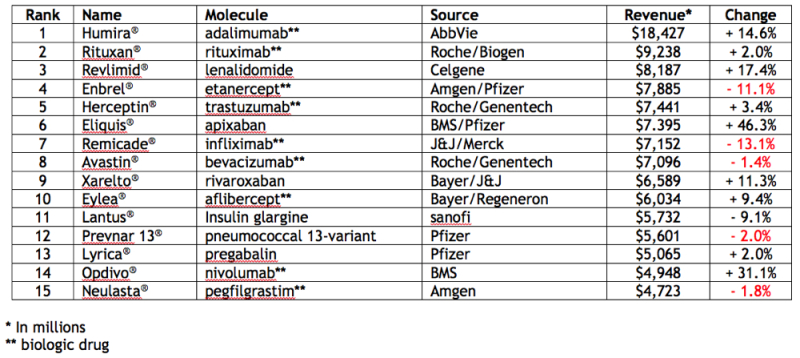
Increased drug costs have been a political and economic target for more than the past generation, being one of the motivations for the Hatch-Waxman Act in 1984. Drug costs were a big part of Ross Perot's campaign in 1992, Hillary Clinton's ill-fated healthcare plans when she was First Lady, and President George W. Bush's changes to Medicare/Medicaid during his second term. Negotiating drug prices was also a lynchpin of President Obama's Affordable Care Act, and the high cost of biologic drugs created the political climate for the Biologic Price Competition and Innovation Act in 2011.
The continuing relevance of high drug costs to most Americans is illustrated by the resonance the issue had for Senator Sanders in 2016 and is likely to have for a variety of politicians of all stripes in 2020. And this concern is well founded as shown by increase in drug prices for the top 15 drugs by revenue as reported recently in Genetic Engineering and Biotechnology News ("The Top 15 Best-Selling Drugs of 2017: Amid Talk of Curbing Prices, Most Treatments Show Sales Gains," by Alex Phillipidis). As quoted in the article, drug spending is projected to reach almost $600 billion by 2020, which is almost double drug spending costs in 2015 ($337 billion), according to America's Health Insurance Programs (AHIP). Of the top fifteen drugs for 2017, two-thirds (9/15) of these drugs are biologic drugs, and nine drugs showed sales gains greater than 50%, with five of these nine showing double-digit growth. And the drugs ranked #16-#20 (Victoza®/liralutide (Novo Nordisk); Stelara®/ustekinamab (J&J); Tecfidera®/dimethyl fumarate (Biogen); Advair®/fluticasone and Seretide®/ salmeterol (GSK); and Harvoni®/ ledipasvir + sofosbuvir (Gilead)) each had sales of between $3.9 billion and $4.4 billion in 2017. Those drugs showing sales declines were most likely due to generic competition and/or insurer discounts, according to GEN. Treatment targets for these drugs include diseases of aging such as cancer (6 drugs), arthritis (4), and diabetes (1), and chronic illnesses like Crohn's disease (2).
Perhaps as a counterweight this trend, UnitedHealthcare announced on March 6th that it would expand discounts to more than seven million individuals enrolled in commercial group health insurance plans.
The data reported in the article is tabulated below (click on table to expand).
